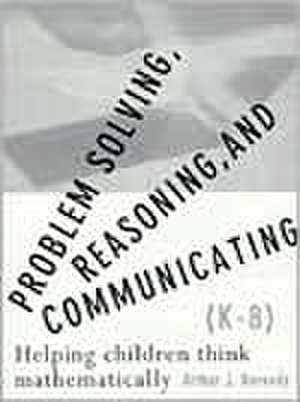Baroody, A: Problem Solving, Reasoning and Communicating K-8
Autor Arthur J. Baroody, Ronald T. Coslicken Limba Engleză Paperback – 15 dec 1992
Preț: 184.13 lei
Preț vechi: 242.22 lei
-24% Nou
Puncte Express: 276
Preț estimativ în valută:
35.24€ • 38.30$ • 29.62£
35.24€ • 38.30$ • 29.62£
Carte tipărită la comandă
Livrare economică 24-30 aprilie
Preluare comenzi: 021 569.72.76
Specificații
ISBN-13: 9780023064883
ISBN-10: 0023064889
Pagini: 160
Dimensiuni: 210 x 276 x 9 mm
Greutate: 0.47 kg
Ediția:1
Editura: Pearson Education
Locul publicării:Boston, United States
ISBN-10: 0023064889
Pagini: 160
Dimensiuni: 210 x 276 x 9 mm
Greutate: 0.47 kg
Ediția:1
Editura: Pearson Education
Locul publicării:Boston, United States
Cuprins
1. Prologue.
2. Problem Solving, Reasoning, and Communicating.
3. What the NCTM Curriculum Standards Say.
4. Mathematics as Problem Solving.
5. The Case of the Loosely Used Term.
6. A Case of Stunted Growth.
7. The Problem Solving Process.
8. Problem Solving Instruction.
9. Mathematics as Reasoning.
10. Reasons for Focusing on Reasoning.
11. Children's Natural Strengths and Weaknesses.
12. Reasoning Instruction.
13. Mathematics as Communication.
14. Reasons for Focusing on Communication.
15. Building a Mathematical Community.
16. Fostering All Aspects of Communicating.
17. For Further Explanation.
18. Some Instructional Resources.
19. Sample of Children's Literature.
20. Tips on Using Technology.
21. Questions to Consider.
22. Things to Do.
23. Questions to Check Understanding.
Problems.
Answers to Selected Questions.
Source Notes.
References.
Caracteristici
- It provides in-depth discussion of how to implement the first three standards for grades K-4 and 5-8: mathematics as problem solving, mathematics as reasoning, and mathematics as communicating,
- Topics covered include the pros and cons of a problem-solving approach; general problem-solving strategies; common difficulties in teaching problem-solving; reasons for focusing on reasoning; the role of conjectures in the classroom; exploring patterns, reasons for focusing on communicating, advantages and problems of small-group cooperative learning; and, writing to learn.
- Throughout this volume, readers are actively involved in the same type of learning experiences the authors would have them use with young learners. Rather than simply discuss problem solving, reasoning, and communicating, the authors invite readers to use these skills to solve a variety of mathematical and pedagogical problems. The aim is to model the kinds of individual and collaborative learning readers will want to use in their own classrooms.
